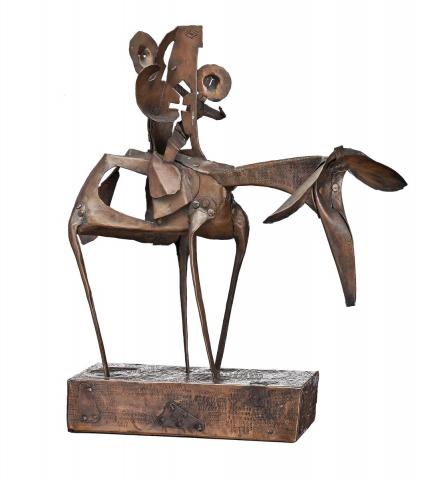FLIGHT TO EGYPT I, 1964
DONALD FRIEND
copper and wood
59.5 cm height
stamped with initials and date at base: DF / 1964
Clune Galleries, Sydney
The Estate of the late James O. Fairfax AC, New South Wales
Donald Friend. Sculpture With Mitty Lee Brown, Clune Galleries, Sydney, 15 April – 8 May 1964, cat. 4
Gleeson, J., ‘The Art Collectors 3. James O. Fairfax’, Art and Australia, Ure Smith, Sydney, vol. 3, no. 3, December 1965, pp. 176 (illus.)
Hughes, R., Donald Friend, Edwards and Shaw, Sydney, 1965, p. 76
Hetherington, P., The Diaries of Donald Friend Vol. 3, National Library of Australia, Canberra, 2005, p. 560
The five years Donald Friend spent in Ceylon (Sri Lanka) from the late 1950s had a profound effect on his art. Always fascinated by non-Western cultures, he had already experienced time living within indigenous communities in Africa and Australia, and between 1957 and 1962, Friend based himself outside Colombo at the home of the plantation-owner Bevis Bawa. Here he occupied his time studying ‘Indian frescoes and sculpture with as much concentration as, eight years before, he had spent on the Renaissance’.1 Apart from creating copious drawings and paintings, Friend started fashioning his own sculptural pieces from sheet aluminium and also experimented with other media, making ‘small fountain statues in brass and copper with the aid of Plastic Metal. … The first ‘fountain’ (Rape of the Sabine Women) was only a qualified success’.2 Friend subsequently held an exhibition of these works in Colombo in 1962.
That same year, the artist returned to Sydney and purchased a small house in Paddington. Due to its cramped size, his colleague Mitty Lee-Brown offered him the use of the old stable at the rear of her nearby property. He also met the young art critic Robert Hughes who would often stop by to ‘(waste) a few hours with his good talk and enthusiasm’.3 Now working with sheets of copper, Friend dedicated himself to a new group of figurative sculptures. In late 1963 Lee-Brown suddenly sold her home and moved to a country property at Nimmitabel close to the Snowy Mountains, forcing Friend to travel there to complete his work. By this stage, Hughes had started writing a monograph on the artist and would often travel down to study the sculptures’ progress. Lee-Brown and Friend held a two-person show of their artwork in April 1964 and Hughes perceptively described his pieces as being ‘not so much sculptures … as three-dimensional drawings made with copper lines in the air. Some, like Flight into Egypt, 1964 have a truly plastic quality’.4 Whilst most of the companion pieces were inspired by Greek mythology, the two exhibited versions of Flight into Egypt were the only ones based on the bible, no doubt mindful of Friend’s success in winning the Blake Prize for Religious Art in 1955.5 With a beaten surface animated by alphabetical letter-punchers, Joseph’s noble profile contrasts with the rounded halo shapes of his wife and the Holy Child, astride their mount which strains with latent energy reminiscent of Marino Marini’s equestrian statues. Friend’s long-time associate James Fairfax purchased this first version of Flight into Egypt and proudly displayed it on an antique sideboard in the entrance hall to his Bowral home Retford Park under Ian Fairweather’s painting Meeting Donkey. He would later commission Friend to create a suite of ambitious murals for the same property.
1. Hughes, R., Donald Friend, Edwards and Shaw, Sydney, 1965, p. 68
2. Friend, D., diary entry 24 December 1959, quoted in Hetherington, P. (ed.), The Diaries of Donald Friend (Volume 3), National Library of Australia, Canberra, 2005, pp. 480 – 481. Fountains, murals and other artworks by Friend are still located at the Bawa estate.
3. Friend, D., diary entry 30 January 1963, quoted in Hetherington, P. (ed.), op cit., p. 546
4. Hughes, R., op cit., pp. 74, 76
5. Both versions were made between late February and early March 1964.
ANDREW GAYNOR
Australian art specialist, writer and researcher
